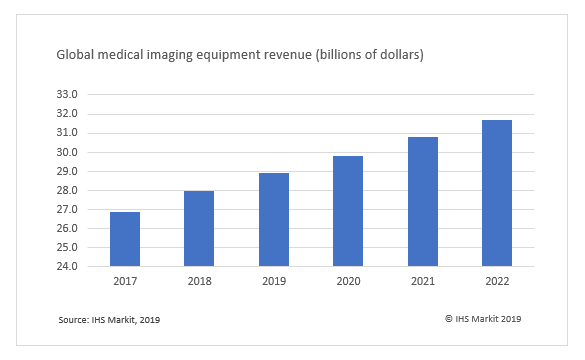As the number of people in the world aged 60 and above more than
doubles by 2050 from current levels, the planet’s aging
population—along with a corresponding rise in chronic illness
within the group—will pose a challenge to global healthcare
systems.
While healthcare stakeholders today face the daunting task of
delivering quality services across the care continuum, providing
healthcare for older populations is more expensive and requires
more resources. As people age, the incidence of chronic diseases
like diabetes and heart disease also rises, and treatment for
chronic illnesses is costly. As a result, health systems must
devise strategies to tackle the problem. Part of the strategy to
improve patient care—and boost efficiencies in the
process—is for medical establishments to invest in new
technology and devices to take advantage of new models of diagnosis
and therapy.
Medical imaging technology, for instance, will play a major role
in addressing chronic health concerns, with strategies focusing on
preventative health, which should promote the regular use of
medical imaging equipment. Diagnostic imaging, meanwhile, will play
a crucial role in the early detection of chronic diseases and the
monitoring of disease progression. For its part, interventional
imaging equipment will be utilized to guide an increasing number of
minimally invasive interventional procedures, including heart-valve
replacements and angioplasties.
The global medical imaging market in 2018 was worth $27.9
billion. This year, the market is projected to rise 3.5% to $28.9
billion, as shown in the graphic below. From 2017 to 2022, the
world’s medical imaging market will expand at a compound annual
growth rate (CAGR) of 3.2%.

Over the years, demand for diagnostic imaging and interventional
procedures is projected to increase, and the market should
experience strong growth.
Even so, market expansion could be offset by the strain of
caring for an aging population, with health systems pushed to do
more imaging scans because of rising rates of illness and disease.
Given the increased financial burden placed by a larger populace
that is sick, medical systems could well reallocate healthcare
spending, moving funds away from medical imaging budgets.
New approach is needed in the face of consolidation and
changing dynamics
The financial burden on healthcare systems is creating an
environment in which hospitals are consolidating at a much faster
rate than in the past few years. Hospitals are purchasing medical
equipment in bulk, and major supplier contracts are often won by
the big three—American firm GE Healthcare, Philips Healthcare
of the Netherlands, and Germany’s Siemens Healthcare.
The three enjoy an enormous advantage because of their wide
product portfolios and capability to bundle imaging equipment
across a variety of modalities, such as CT, MRI, and ultrasound. Of
the total medical imaging equipment market in 2017, the three firms
accounted for nearly 60% of revenue.
A shift in the healthcare delivery environment will also require
medical imaging manufacturers to adjust their sales approach and
strategies. Medical reimbursement to healthcare providers is now
tied to patient outcomes instead of the number of services
performed—a change in approach from volume- to value-based
care—driving providers to find ways to achieve new economies of
scale to improve patient care while reducing their own costs.
This means that more than ever, medical imaging manufacturers
must demonstrate their equipment to have the best return on
investment (ROI), especially as purchasing decisions have moved
away from clinicians to hospital administrators and even C-level
executives.
To convince hospitals of the investment worth of their
equipment, medical imaging manufacturers are showing how their
devices can improve workflow efficiency and increase patient
comfort. And increasingly, manufacturers are finding ways to
incorporate into their product portfolios functionality that can be
tied to artificial intelligence (AI).
The most discussed subject today in the medical imaging
industry, AI has been shown to be more accurate when employed in
diagnosis than in radiologists working alone. With the potential to
improve patient incomes and drive down costs, AI integration will
be a key feature in all medical imaging products, with integration
projected to begin in the next three to five years, IHS Markit is
forecasting.
Manufacturers who establish themselves as a leader in this field
will have the best chance of claiming a major stake in this
potentially huge market.
Holley Lewis is senior analyst for healthcare technology
at IHS Markit
Posted 24 June 2019